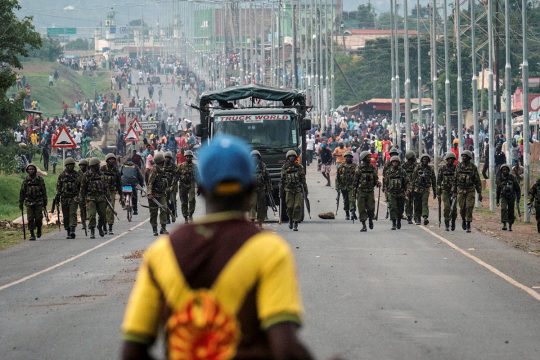Below are key dates since post-election violence in Kenya in 2007-2008 left more than 1,100 people dead, the worst violence in the east African country since independence in 1963:
- 2007-2008: post election violence -
On December 27, 2007, outgoing president Mwai Kibaki is proclaimed winner again but his challenger Raila Odinga says the vote was rigged.
Clashes in the following weeks kill more than 1,100 people and force 600,000 from their homes, in a country that had previously been renowned for its stability.
The epicentre of the violence is the Rift Valley, pitting members of the Kalenjin and Luo ethnic communities, who mainly back Odinga, against the Kikuyu, to which Kibaki belongs.
On February 28, 2008 an internationally-brokered power-sharing agreement is signed under which Kibaki keeps his job and Odinga becomes prime minister.
In March 2010 the International Criminal Court (ICC) authorises the opening of a probe for crimes against humanity over the 2007-2008 violence.
In 2012 its judges confirm accusations against four Kenyans, including Uhuru Kenyatta and William Ruto.
- 2013: Uhuru Kenyatta in power -
On March 4, 2013, Kenyatta, the son of Kenya's first post-colonial leader Jomo Kenyatta, narrowly wins the first round of the presidential vote with Ruto as his running-mate.
On April 9, Kenyatta is sworn in in the presence of several African heads of state, but in the absence of western leaders. Ruto becomes vice president.
- 2014: First sitting president before the ICC -
On October 8, Kenyatta becomes the first sitting head of state to appear before the ICC. But on December 5, the Court drops its case against him, while denouncing intimidation of witnesses.
The ICC's proceedings against Ruto, also for crimes against humanity for the 2007-2008 violence, are dropped in April 2016 due to lack of evidence.
- 2015: Massacre at Garissa -
Kenya has been targeted by a spate of attacks since its military intervened in neighbouring Somalia in October 2011 to fight Al-Qaeda-linked Shabaab militants.
On September 21, 2013, gunmen storm Nairobi's Westgate mall killing at least 67 people.
And on April 2, 2015 commandos attack the university at Garissa in eastern Kenya. They separate out Muslims and non-Muslims, killing the latter. In all, 148 people are killed, including 142 students. Shabaab claims responsibility.
- 2017: Violence mounts -
On July 22, 2017, a parliamentarian is arrested for inciting violence at a meeting attended by Odinga. He had already been charged in March for encouraging the invasion of land.
The region of Laikipia, which he represents, has seen periodic invasions of farms by herders seeking pasture for their livestock, against a background of drought.
On July 30, an attack takes place at the country home of Ruto, who is away. An attacker and a police officer die during a 20-hour siege. A day later a top official overseeing Kenya's electronic voting system is found dead, his body showing signs of torture.
Many observers express concerns over violence in the districts of Laikipia and Baringo, in the Rift Valley, which forces inhabitants to flee their homes.



